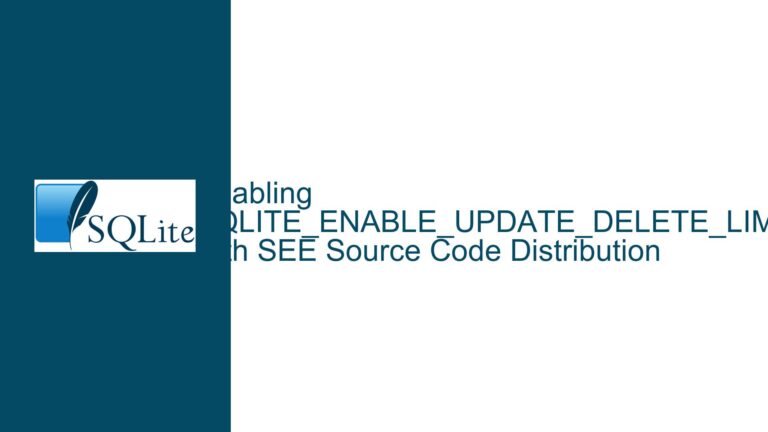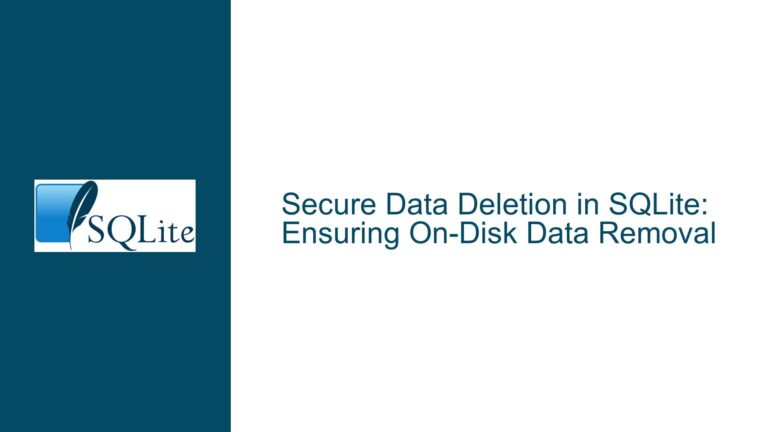SQLite3 Valgrind Reports: Expected Reachable Memory at Exit
Understanding Valgrind’s "Still Reachable" Memory in SQLite3 CLI
Valgrind’s "Still Reachable" Memory Warnings in SQLite3 CLI
The core issue revolves around Valgrind reporting "still reachable" memory blocks when running the SQLite3 command-line interface (CLI). These reports indicate that memory allocations persist at program termination but are not classified as leaks (i.e., "definitely lost," "indirectly lost," or "possibly lost"). Users observing this behavior often question whether their custom modifications to the SQLite3 amalgamation (e.g., user-defined functions or initialization logic) introduced memory management flaws. However, in most cases, the "still reachable" blocks stem from third-party dependencies or intentional design choices in the SQLite3 CLI.
Key Observations from the Forum Discussion:
Valgrind Output Analysis:
- A vanilla SQLite3 CLI build (without user modifications) reports 388,716 bytes in 6,236 blocks as "still reachable" at exit.
- A modified build with user-added code shows a marginal increase (388,804 bytes in 6,237 blocks), suggesting minimal additional allocations.
- The absence of "definitely lost" or "possibly lost" blocks implies no critical memory leaks.
Source of Allocations:
- The largest allocation (63,798 bytes in 1,999 blocks) traces to
read_history_rangein the GNU Readline library, used for command-line editing. - Other allocations originate from dependencies like
libreadline,libncurses, andlibz, which are linked to the CLI but not part of the SQLite library itself.
- The largest allocation (63,798 bytes in 1,999 blocks) traces to
SQLite’s Memory Management Philosophy:
- The SQLite library rigorously avoids memory leaks. Its test suite includes checks for orphaned allocations during long-running sessions.
- The CLI (
shell.c) includes debug mechanisms (e.g.,mem_main_enter) to verify that the SQLite library’s allocator does not leak memory. However, these checks do not cover system allocators likemalloc()/free(), which Valgrind monitors.
Why This Matters:
Developers integrating SQLite3 into applications or extending the CLI must distinguish between:
- Library-level leaks (critical, as they degrade performance over time).
- Process-lifetime allocations (benign, as the OS reclaims memory upon exit).
The Valgrind warnings observed here fall into the latter category, arising from static allocations in third-party libraries or CLI utilities.
Root Causes of "Still Reachable" Allocations in SQLite3 CLI
The persistence of reachable memory blocks at exit can be attributed to four primary factors:
Third-Party Library Behavior:
- The SQLite3 CLI optionally links to libraries like GNU Readline, ncurses, and zlib for enhanced functionality (e.g., command history, compression).
- These libraries often retain static buffers or caches to improve performance. For example:
- GNU Readline: Maintains a history of commands in memory, which may not be fully freed to avoid the overhead of cleanup during short-lived CLI sessions.
- ncurses: Allocates terminal-handling structures that persist until process termination.
- Such libraries prioritize speed over exhaustive cleanup, as the operating system automatically reclaims memory upon process exit.
SQLite3 CLI Design Choices:
- The CLI employs static variables with process-wide lifetimes to manage global state (e.g., database connections, configuration settings).
- Example: The
mem_main_entervariable inshell.ctracks memory allocations during debug builds to detect library-level leaks. This variable remains reachable until the CLI exits.
Compiler and Linker Optimizations:
- Build flags like
-Os(optimize for size) or-lreadline(link Readline) influence memory layout. Aggressive optimizations may merge or omit cleanup routines for static allocations. - For instance, the
-DSQLITE_THREADSAFE=0flag disables thread-safety checks, altering how memory pools are managed.
- Build flags like
Valgrind’s Heuristic Limitations:
- Valgrind classifies memory as "still reachable" if pointers to it exist in global variables, stack frames, or CPU registers at exit. This does not necessarily indicate a leak.
- Example: The CLI’s
.qcommand triggers an immediate exit, bypassing cleanup routines that would otherwise run during normal shutdown.
Critical Distinction: Reachable vs. Leaked Memory
- Reachable: Memory is tracked by pointers in active data structures. It is not leaked but simply not freed before exit.
- Leaked: Memory has no remaining pointers, making it unreclaimable and a genuine resource drain.
In the SQLite3 CLI, reachable blocks are often intentional or incidental to dependency behavior, whereas true leaks are exceedingly rare due to the library’s strict leak prevention measures.
Resolving and Validating Memory Concerns in Custom SQLite3 Builds
Follow these steps to diagnose whether "still reachable" blocks indicate a problem in your code or are expected behavior:
Step 1: Establish a Baseline with a Vanilla SQLite3 Build
- Compile the SQLite3 CLI without modifications:
gcc -Os shell.c sqlite3.c -ldl -lm -o sqlite3_vanilla - Run Valgrind with detailed leak checking:
valgrind --leak-check=full --show-leak-kinds=all ./sqlite3_vanilla - Note the "still reachable" totals. These represent the expected baseline.
Step 2: Compare Against Your Custom Build
- Recompile with your modifications, ensuring identical compiler flags:
gcc -Os -I. -DSQLITE_THREADSAFE=0 -DHAVE_READLINE shell.c sqlite3.c -lreadline -lncurses -o sqlite3_custom - Run Valgrind and compare the output:
valgrind --leak-check=full --show-leak-kinds=all ./sqlite3_custom - Focus on differences in block counts or sizes. An increase of 1 block and 88 bytes (as in the forum example) likely stems from minor static allocations in your code.
Step 3: Identify Allocation Sources
- Use Valgrind’s
--track-origins=yesand--leak-check=fullflags to trace allocations:valgrind --track-origins=yes --leak-check=full --show-leak-kinds=all ./sqlite3_custom - Look for stack traces pointing to your code. Example:
==21195== 63,798 bytes in 1,999 blocks are still reachable in loss record 80 of 80 ==21195== by 0x498D53B: read_history_range (histfile.c:422)This implicates Readline’s history functions, not SQLite.
Step 4: Audit Custom Code for Memory Management
- User-Defined Functions (UDFs):
- Ensure UDFs free allocated memory using
sqlite3_free()orfree()in destructor callbacks. - Example:
sqlite3_create_function(db, "my_udf", 1, SQLITE_UTF8, NULL, &my_udf_impl, NULL, NULL);If
my_udf_implallocates memory, provide a destructor:void my_udf_destroy(void *p) { free(p); } sqlite3_create_function(db, "my_udf", 1, SQLITE_UTF8, NULL, &my_udf_impl, NULL, &my_udf_destroy);
- Ensure UDFs free allocated memory using
- Static Variables:
- Avoid global variables that hold memory references. Use
sqlite3_auto_extension()for initialization if needed.
- Avoid global variables that hold memory references. Use
Step 5: Suppress Benign Warnings
- Create a Valgrind suppression file (
sqlite3.supp) to ignore known third-party allocations:{ readline_history Memcheck:Leak fun:*alloc_history_entry* ... } - Run Valgrind with
--suppressions=sqlite3.suppto filter noise.
Step 6: Test for True Leaks
- Run the CLI in a loop to detect growth in memory usage:
for i in {1..1000}; do echo "SELECT $i;" | ./sqlite3_custom done - Monitor resident memory with
toporhtop. Stable memory usage confirms no leaks.
Final Recommendations:
- Ignore "still reachable" blocks from Readline, ncurses, or zlib. These are not leaks.
- Investigate "definitely lost" blocks immediately, as they indicate SQLite library or custom code leaks.
- Use SQLite’s built-in memory statistics (
sqlite3_memory_used()) to track allocations during runtime.
By methodically comparing vanilla and custom builds, auditing allocation sources, and leveraging Valgrind’s diagnostics, developers can confidently attribute memory reports to either harmless third-party behavior or genuine issues in their code.






